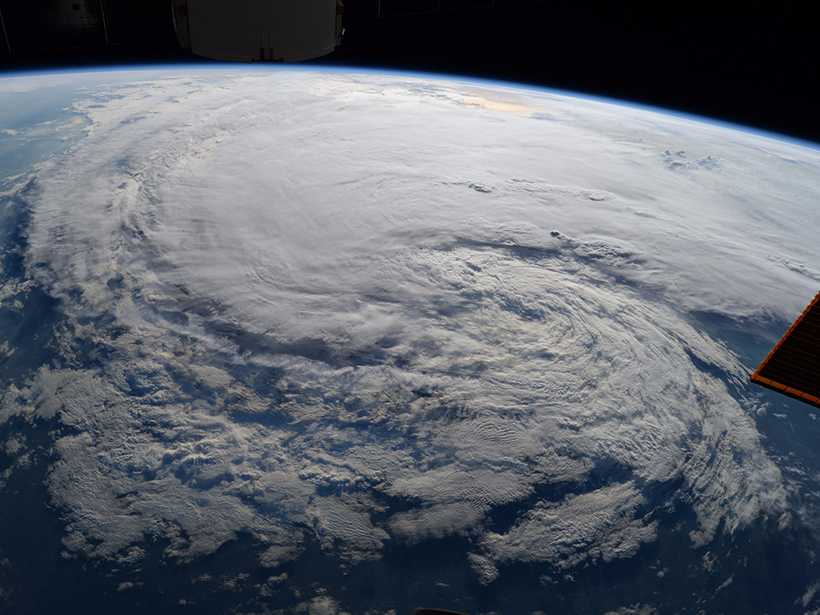Hurricane Harvey shocked the world in 2017 when it stalled over Houston, defying hurricane models and dumping 1.25 meters of rain onto the city. According to new research by a team of atmospheric scientists, a previously unaccounted for variable helped to drive the deluge: industrial air pollution.
To investigate the role of air pollution, researchers compared models with and without aerosols to observed data on Hurricane Harvey’s path, rainfall, and lightning extent. They found that air pollution was the major factor that drove catastrophic flooding in Houston, concluding that National Weather Service models failed to predict the rainfall because they didn’t take industrial aerosols into account. They reported their findings last month in Geophysical Research Letters.
“The study presents compelling evidence illustrating the widespread effects of industrial aerosols on the evolution of Hurricane Harvey,” said Zhanqing Li, an atmospheric scientist who specializes in aerosols and was not involved in the study.
The Striking Impact of Aerosols
In recent years, researchers have begun to scrutinize the relationship between air pollution and storms. Wildfires’ combined smoke and heat can affect local weather, for instance, and lightning is more frequent over polluted skies.
Particulate matter, especially very fine soot, can hover in the air for extended periods of time before settling to the ground, providing a focal point around which water molecules can condense. When water droplets form around the particles, a small amount of heat is released. In this way, more pollution leads to more condensed water and more heat, which in turn produces heavier rainfall and more intense lightning.
Conditions in Houston came together to maximize aerosols’ amplifying effects during Hurricane Harvey. Southern Texas has more than 400 densely distributed refineries, and Houston in particular often exceeds national average annual air pollution levels.
But although previous studies have tried to understand how the urban heat island effect and global warming affected Hurricane Harvey, no one had yet focused their attention on the role of the city’s air pollution. “I think we are among the first to argue that the aerosols played a determinant role in producing the large amount of precipitation,” said Yuan Wang, an atmospheric scientist at the California Institute of Technology in Pasadena and coauthor of the study.
Hurricane Harvey’s Perfect Storm
During the time that Hurricane Harvey sat over Houston, a continuous source of moisture was coming in from the Gulf of Mexico. On top of that already hefty source of rain, factories continued to spew out more aerosols, providing a continuous source of air particles to supercharge the storm.
“In this case, all the factors came together to set the stage for aerosols to play a huge role,” Wang said.
The team’s findings indicate that greenhouse gas emissions can have profound impacts on extreme weather events even at the local level.
To test the idea that Houston’s air pollution played a role in Hurricane Harvey’s record-smashing rainfall, the team looked at both ground- and satellite-based rain and lightning measurements to get a clear understanding of the actual amount of rainfall and lightning over Houston between 26 and 28 August 2017. They then used the cloud-resolving Weather Research and Forecasting model to simulate Hurricane Harvey with and without the presence of Houston’s industrial air pollution.
The simulation incorporating air pollution data accurately modeled Hurricane Harvey’s actual rainfall rate of 32 mm per hour and also predicted the particularly intense lightning observed during the hurricane. The “clean” simulation, in contrast, predicted less than half that rate of rainfall.
The team’s findings indicate that greenhouse gas emissions can have profound impacts on extreme weather events even at the local level, Wang said. Failing to take these impacts seriously can have serious consequences and heavy costs.
“Traditionally, in the hurricane community, aerosol effects have always been neglected in operational forecast models,” Li said. “This work shows that such an omission may lead to significant errors in hurricane forecast and predictions.”
—Rachel Fritts (@rachel_fritts), Science Writer
Citation:
Fritts, R. (2020), To make better hurricane models, consider air pollution, Eos, 101, https://doi.org/10.1029/2020EO153044. Published on 23 December 2020.
Text © 2020. The authors. CC BY-NC-ND 3.0
Except where otherwise noted, images are subject to copyright. Any reuse without express permission from the copyright owner is prohibited.

